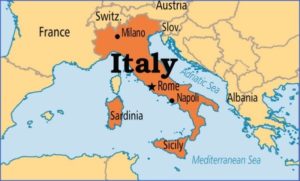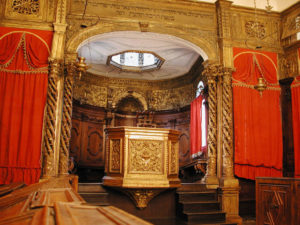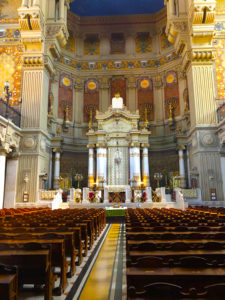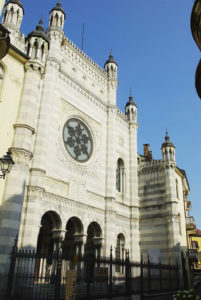 The history of the Jews in Italy spans more than two thousand years to the present. The Jewish presence in Italy dates to the pre-Christian Roman period and has continued, despite periods of extreme persecution and expulsions, until the present. It is estimated that in 1492 Jews made up between 3% and 6% of the population of Sicily. Many Sicilian Jews first went to Calabria, which already had a Jewish community since the 4th century. In 1524 Jews were expelled from Calabria, and in 1540 from the entire Kingdom of Naples, as all these areas fell under Spanish rule and were subject to the edict of expulsion by the Spanish Inquisition.
The history of the Jews in Italy spans more than two thousand years to the present. The Jewish presence in Italy dates to the pre-Christian Roman period and has continued, despite periods of extreme persecution and expulsions, until the present. It is estimated that in 1492 Jews made up between 3% and 6% of the population of Sicily. Many Sicilian Jews first went to Calabria, which already had a Jewish community since the 4th century. In 1524 Jews were expelled from Calabria, and in 1540 from the entire Kingdom of Naples, as all these areas fell under Spanish rule and were subject to the edict of expulsion by the Spanish Inquisition.
 With the arrival of the Counter-Reformation, when the first Italian “Grand Inquisitor” became Pope in 1555, Jews were ordered to be locked up in what was only later called a ghetto. At that time they were only allowed to have one synagogue. Napoleon’s victorious armies brought civic emancipation to the Jews in the 18th Century. During the Unification of Italy the Jews acquired a full set of human rights, and immigrated to Bologna from other parts of Italy and from abroad.
With the arrival of the Counter-Reformation, when the first Italian “Grand Inquisitor” became Pope in 1555, Jews were ordered to be locked up in what was only later called a ghetto. At that time they were only allowed to have one synagogue. Napoleon’s victorious armies brought civic emancipation to the Jews in the 18th Century. During the Unification of Italy the Jews acquired a full set of human rights, and immigrated to Bologna from other parts of Italy and from abroad.
From 1830 to 1930 the city’s Jewish population in Bologna rose from about 100 to about 900. They were finally able to build a synagogue in 1877. Approximately 5,000 Italian Jews were conscripted during World War I and about half of them served as officers.
 In 1938, under the Italian Racial Laws, imposed by the fascist regime of Benito Mussolini, Italian Jews lost their civil rights, including those to property, education and employment. They were removed from government jobs, the armed forces, and public schools. In June 1940, after the outbreak of World War II, the Fascist Italian government opened around 50 concentration camps. These were used predominantly to hold political prisoners but also around 2,200 Jews of foreign nationality (Italian Jews were not interned). The Jews in these camps were treated no differently than political prisoners. While living conditions and food were often basic, prisoners were not subject to violent treatment. While most Italian concentration camps were police and transit camps, one camp, the Risiera di San Sabba in Trieste, was also an extermination camp. It is estimated that up to 5,000 political prisoners died there. More than 10,000 political prisoners and 40,000-50,000 captured Italian soldiers were interned and killed overall.
In 1938, under the Italian Racial Laws, imposed by the fascist regime of Benito Mussolini, Italian Jews lost their civil rights, including those to property, education and employment. They were removed from government jobs, the armed forces, and public schools. In June 1940, after the outbreak of World War II, the Fascist Italian government opened around 50 concentration camps. These were used predominantly to hold political prisoners but also around 2,200 Jews of foreign nationality (Italian Jews were not interned). The Jews in these camps were treated no differently than political prisoners. While living conditions and food were often basic, prisoners were not subject to violent treatment. While most Italian concentration camps were police and transit camps, one camp, the Risiera di San Sabba in Trieste, was also an extermination camp. It is estimated that up to 5,000 political prisoners died there. More than 10,000 political prisoners and 40,000-50,000 captured Italian soldiers were interned and killed overall.
The arrest of Jewish Italians and Jewish refugees began almost immediately after the surrender, in October 1943. This took place in all major Italian cities under German control, albeit with limited success. The Italian police offered little cooperation, and ninety percent of Rome’s 10,000 Jews escaped arrest. Arrested Jews were taken to the transit camps at Borgo San Dalmazzo, Fossoli and Bolzano, and from there to Auschwitz. Italy had a pre-war Jewish population of 40,000 but, through evacuation and refugees, this number increased during the war. Of the estimated 44,500 Jews living in Italy before September 1943, 7,680 died during the Holocaust, while nearly 37,000 survived. In this, the Italian police and Fascist militia played an integral role as the Germans’ accessories. Unlike Jews in other Axis-aligned countries, no Jews in Italy or Italian-occupied areas were murdered or deported to concentration camps in Germany before September 1943.
 In the nineteen months of German occupation, from September 1943 to May 1945, twenty percent of Italy’s pre-war Jewish population was killed by the Nazis. Apart from the extermination of the Jews, Nazi Germany was also extremely interested in appropriating Jewish property. A 2010 estimate set the value of Jewish property looted in Italy during the Holocaust between 1943 and 1945 at US$1 billion.
In the nineteen months of German occupation, from September 1943 to May 1945, twenty percent of Italy’s pre-war Jewish population was killed by the Nazis. Apart from the extermination of the Jews, Nazi Germany was also extremely interested in appropriating Jewish property. A 2010 estimate set the value of Jewish property looted in Italy during the Holocaust between 1943 and 1945 at US$1 billion.
In the territories occupied by the Italian Army in Greece, France and Yugoslavia, Jews even found protection from persecution. The Italian Army actively protected Jews in occupation zones, to the frustration of Nazi Germany. This changed in September 1943, when German forces occupied the country, installed the puppet state of the Italian Social Republic and immediately began persecuting and deporting the Jews found there.
People who helped the Jews during the Holocaust include: Monsignor Angelo Rotta, Monsignor Francesco Repetto, Odoardo Focherini, Gino Bartali, and Giorgio Perlasca.

Monsignor Angelo Rotta was the Apostolic Nuncio in Hungary during the period of the Holocaust. Rotta issued letters of Vatican protection for Jews serving in military labor-service companies. During the Arrow Cross period, Rotta sent his representative, to follow the Jews who were sent by foot on death marches from Budapest to Vienna. Rotta received approval from the Hungarians to issue 2,500 letters of Vatican protection to Jews, but signed more than 19,000 such documents.
Monsignor Francesco Repetto was a lead in the clandestine DELASEM organization, which contributed to the saving of thousands of Jews during the Holocaust in Italy. DELASEM, was dedicated to providing assistance to the growing number of Jewish refugees in Italy. Repetto distributed financial aid to Massimo Teglio, known as The Scarlet Pimpernel. Teglio re-organized DELASEM as a clandestine organization and produced false identity cards in private homes and hideouts in religious houses, while Father Repetto served as treasurer for the collection and distribution of the money that came from Switzerland through the American Jewish Joint Distribution Committee.
Odoardo Focherini began building a clandestine network, producing false documents and escorting more than a hundred Jewish refugees across the Italian border into Switzerland. Together with a priest, Focherini created a clandestine network of organised aid to hide the Jewish runaways, to secure them false identity cards, which he filled out with false data and he guided them until they reached Switzerland.
In September 1943, Gino Bartali carried counterfeit documents and photos in the hollow frame of his bike. In this way hundreds of Jews were saved.
The Spanish embassy gave some 3,000 letters of protection to Jews. When the ambassador left Hungary, Giorgio Perlasca pretended to be the representative of Spain. He signed letters issued by the diplomatic corps calling for the end of anti-Jewish persecutions. He distributed letters of protection to those who were being deported on the death marches. Thanks to these documents many Jews were allowed to return from the marches, or from the border. Perlasca provided shelter and food for the Jews who were in the Spanish protected houses. He succeeded in saving 5218 Jews.
 On July 25, 1943, with the fall of the Fascist Regime and the arrest of Benito Mussolini, the situation in the Italian concentration camps changed. Inmates, including Jewish prisoners, were gradually released. However, this process was not completed by the time German authorities took over the camps in northern-central Italy on September 8, 1943. Luckily, hundreds of Jewish refugees who were imprisoned in the major camps were liberated by the Allies before the arrival of the Germans, but 43,000 Jews (35,000 Italians and 8,000 refugees from other countries) were trapped in the territories now under control of the Italian Social Republic.
On July 25, 1943, with the fall of the Fascist Regime and the arrest of Benito Mussolini, the situation in the Italian concentration camps changed. Inmates, including Jewish prisoners, were gradually released. However, this process was not completed by the time German authorities took over the camps in northern-central Italy on September 8, 1943. Luckily, hundreds of Jewish refugees who were imprisoned in the major camps were liberated by the Allies before the arrival of the Germans, but 43,000 Jews (35,000 Italians and 8,000 refugees from other countries) were trapped in the territories now under control of the Italian Social Republic.
A number of Jews came from Hungary after the war, but especially Jews from Egypt, Tunisia and Libya settled on the peninsula on the years 1950-1960. The size of the Italian Jewish community has faced a slight but continuous drop throughout the postwar decades, partly because of emigration to Israel or the United States and partly because of low birth rates, assimilation and intermarriage, especially in the small congregations of the North. A significant increase occurred during the 1970s due to the arrival of Iranian Jews (following the ousting of the Shah) and North African Jews (mainly coming from Libya in the aftermath of Gaddafi’s seizure of power).
As of 2019, the estimated core Jewish population in Italy numbers around 45,000. The strongest community is that of Rome, which is the most deeply rooted in its dialect, traditions, and cuisine. There are other communities in: Milan, Turin, Florence and Leghorn (Livorno). Other Jewish communities numbering a few hundred members in each city can be found in Bologna, Genoa, Triste, with even smaller enclaves in Ancona, Naples Padua, Pisa, Modena, Siena, Parma, Verona.